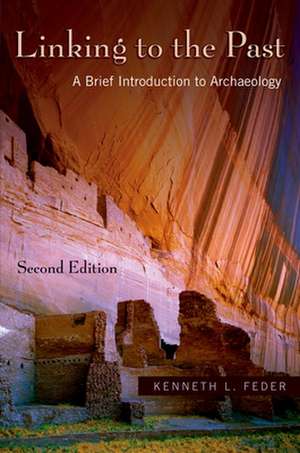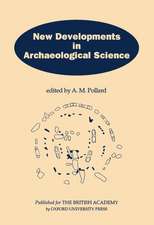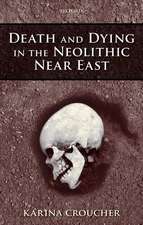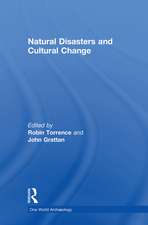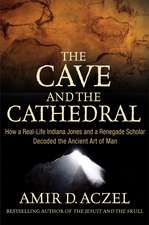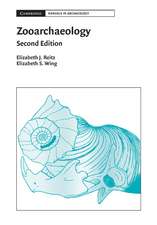Linking to the Past
Autor Kenneth L. Federen Limba Engleză Mixed media product – 20 noi 2007
* A completely reorganized structure that ensures all students take the same pathway to learning the material traditionally covered in an archaeology course
* An expanded focus that covers the whole of the archaeological experience (including ceramics, theory, and human burials) and integrates examples from around the globe
* Updated material on such cutting-edge technology and theory as transformation processes, GIS, Total Station, glacial dating, and aerial photography
* Discussions of current issues facing archaeology, including federal legislation that protects archaeological sites
* More in-depth coverage of the scientific method; the history and development of archaeology; various theoretical approaches; and the archaeology of social inequality, race, gender, and the sacred
* An in-text CD with interactive student exercises and slide shows
Written in a conversational style, Linking to the Past: A Brief Introduction to Archaeology, Second Edition, offers students a concise and entertaining introduction to archaeological methods. Author Kenneth L. Feder helps students relate to the study of the past and learn what it means to think like an archaeologist by using accessible examples drawn from daily life; he examines the evolution of the beer and soda can to teach about seriation, demonstrates how technology changes over time with an iPod, and introduces dendrochronology by discussing a tree that fell on his property during a storm. Employing an "ask-and-answer" approach, Feder leads students through a wide-ranging series of questions about how archaeologists find, recover, study, and interpret the material culture left behind by earlier peoples.
To give students an opportunity to think like archaeologists, the author offers interactive student exercises and slide shows (provided on the in-text CD). Linked to chapters in the text, the exercises on the CD include exploring a topographic map to see what features might support human habitation, translating radiocarbon dates into calendar years, and calculating the age at death of a sample of human beings by examining their skeletal features. The text is also enriched by additional pedagogical features including detailed study questions at the end of each chapter, an extensive glossary of more than 200 key terms, and suggestions for further reading. An Instructor's Manual on CD is also available.
Preț: 766.51 lei
Preț vechi: 1050.02 lei
-27% Nou
Puncte Express: 1150
Preț estimativ în valută:
146.74€ • 150.91$ • 121.74£
146.74€ • 150.91$ • 121.74£
Carte tipărită la comandă
Livrare economică 20 februarie-06 martie
Preluare comenzi: 021 569.72.76
Specificații
ISBN-13: 9780195331172
ISBN-10: 0195331176
Pagini: 474
Dimensiuni: 155 x 231 x 28 mm
Greutate: 0.7 kg
Ediția:2 PAP/CDR
Editura: Oxford University Press
Colecția Oxford University Press USA
ISBN-10: 0195331176
Pagini: 474
Dimensiuni: 155 x 231 x 28 mm
Greutate: 0.7 kg
Ediția:2 PAP/CDR
Editura: Oxford University Press
Colecția Oxford University Press USA
Descriere
This thoroughly revised Second Edition of Linking to the Past features:* A completely reorganized structure that ensures all students take the same pathway to learning the material traditionally covered in an archaeology course* An expanded focus that covers the whole of the archaeological experience (including ceramics, theory, and human burials) and integrates examples from around the globe* Updated material on such cutting-edge technology and theory as transformation processes, GIS, Total Station, glacial dating, and aerial photography* Discussions of current issues facing archaeology, including federal legislation that protects archaeological sites* More in-depth coverage of the scientific method; the history and development of archaeology; various theoretical approaches; and the archaeology of social inequality, race, gender, and the sacred* An in-text CD with interactive student exercises and slide showsWritten in a conversational style, Linking to the Past: A Brief Introduction to Archaeology, Second Edition, offers students a concise and entertaining introduction to archaeological methods. Author Kenneth L. Feder helps students relate to the study of the past and learn what it means to think like an archaeologist by using accessible examples drawn from daily life; he examines the evolution of the beer and soda can to teach about seriation, demonstrates how technology changes over time with an iPod, and introduces dendrochronology by discussing a tree that fell on his property during a storm. Employing an "ask-and-answer" approach, Feder leads students through a wide-ranging series of questions about how archaeologists find, recover, study, and interpret the material culture left behind by earlier peoples. To give students an opportunity to think like archaeologists, the author offers interactive student exercises and slide shows (provided on the in-text CD). Linked to chapters in the text, the exercises on the CD include exploring a topographic map to see what features might support human habitation, translating radiocarbon dates into calendar years, and calculating the age at death of a sample of human beings by examining their skeletal features. The text is also enriched by additional pedagogical features including detailed study questions at the end of each chapter, an extensive glossary of more than 200 key terms, and suggestions for further reading. An Instructor's Manual on CD is also available.
Cuprins
PROLOGUE: THE PAST IN THE PRESENTArchaeology: The Study of the Human PastThe Context of AntiquityShadow of the PastCHAPTER 1. HOW I SPENT MY SUMMER VACATION: FINDING, EXCAVATING, AND INTERPRETING THE WOOD LILY SITE IN NORTH-CENTRAL CONNECTICUTA Biography of Archaeology (Chapter 2)What Archaeologists Want to Know (Chapter 3)Doing Archaeology: Practical Considerations (Chapter 4)A Community's Shadow: The Archaeological Site (Chapter 5)Searching for the Past: Archaeological Site Survey (Chapter 6)Revealing the Past: The Archaeological Excavation (Chapter 7)Linked Slide ShowInterpreting the Past: Gauging the Age of an Archaeological Site (Chapter 8)Interpreting the Past: The Environmental Contexts of Antiquity (Chapter 9)Technology: How People Made Things (Chapter 10)Putting Food on the Table: Reconstructing Ancient Diets (Chapter 11)Families, Neighbors,and Strangers: Reconstructing Ancient Social Systems (Chapter 12)Conversing with the Dead: Bioarchaeology (Chapter 13)Wood Lily: Archaeological Portrait of a Life (Chapter 14)CHAPTER 2. A BIOGRAPHY OF ARCHAEOLOGYWhat Is Archaeology?What Do We Mean by the Term Culture?Is Archaeology a Science?How Did Archaeology Get Started in the First Place?Why Is Archaeology in the Anthropology Department?Linked Interactive ExerciseHow Do You Get to Be an Archaeologist?Who Owns the Past?What Kinds of People Go into Archaeology?CHAPTER 3. WHAT ARCHAEOLOGISTS WANT TO KNOWWhat Kinds of Research Goals Do Archaeologists Have?Linked Interactive ExerciseWhat Is It That Archaeologists Want to Find Out?Is Garbage Really All That Informative on the Subject of Human Behavior?CHAPTER 4. DOING ARCHAEOLOGY: PRACTICAL CONSIDERATIONSWhat Determines Where an Archaeologist Investigates in the First Place?How Is Archaeological Research Funded, and Why?What Laws Regulate Where Archaeologists Can Dig?What Are the Ethical Obligations of Archaeologists?Linked Interactive ExerciseWho Gets to Dig at an Archaeological Site?Is Archaeology Really a Dangerous Pursuit?CHAPTER 5. A COMMUNITY'S SHADOW: THE ARCHAEOLOGICAL SITEWhat Is an "Archaeological Site" and How Do You Know When You've Found One?Linked Slide ShowWhat Kinds of Stuff Do Archaeologists Find at Sites?How Are Archaeological Sites Made?Why Do Archaeologists Need to Dig; Why Are Most Sites Buried?How Are Archaeological Sites Altered Once Buried?CHAPTER 6. SEARCHING FOR THE PAST: ARCHAEOLOGICAL SITE SURVEYHow Do Archaeologists Know Where to Look for Sites?Linked Interactive ExerciseHow Can GIS Help Identify Places Where Sites Are Likely to Be Found?What Are the Mechanics of Looking for and Finding Sites?Linked Slide ShowWhat Forms the Basis of an Archaeological "Sampling Strategy"?How Can You Find Archaeological Sites Just by Walking Around?How Deep Do You Have to Dig to Find Archaeological Material?How Can Archaeologists Probe the Subsurface Without Digging Holes?CHAPTER 7. REVEALING THE PAST: THE ARCHAEOLOGICAL EXCAVATIONHow Is Archaeological Research Like Detective Work?How Do You Measure and Record the Precise Location of a Site?How Are Archaeological Sites Named?How Do Archaeologists Excavate Sites?Linked Slide ShowWhy Are Archaeologists So Painstaking and Slow in Excavation?What Tools Do Archaeologists Use to Expose and Recover Artifacts?What Is an Excavation Unit and How Is It Labeled?How Do Archaeologists Keep Track of Where Stuff Is Found at Sites?Why Do Archaeologists Save All the Tiny Scraps of Stone, Bone, and Other Stuff?How Can You Determine the Size of an Ancient Habitation?What Preliminary Work Goes into an Archaeology Laboratory?CHAPTER 8. INTERPRETING THE PAST: GAUGING THE AGE OF AN ARCHAEOLOGICAL SITEHow Old Does Something Have to Be in Order to Be Considered "Archaeological" in the First Place?How Do Archaeologists Know How Old Artifacts and Sites Are?What Are Relative Dating Techniques?How Can You Date Sites by Stratigraphic Analysis?How Can You Determine a Relative Date for a Site by Reference to Artifact Style?What Are Chronometric or Absolute Dating Methods?How Does Dendrochronology Work?What Are the Most Commonly Used Radiometric Dating Methods Relied on by Archaeologists?Linked Interactive ExerciseHow Can the Shifting Location Of Magnetic North Be Used to Date Sites?How Can You Determine an Absolute Date for a Site by Reference to Style?CHAPTER 9. INTERPRETING THE PAST: THE ENVIRONMENTAL CONTEXTS OF ANTIQUITYWhy Do Archaeologists Want to Know About Ancient Environments?Does the Environment Cause Certain Adaptations?How Do Archaeologists Reconstruct the Environment?How Can Little Creatures Called Foraminifera Tell Us About Climate Change?What's Pollen Good For, Besides Making Us Sneeze?What Is a Pollen Profile?Linked Slide ShowHow Can You Identify Tree Species from Bits of Burned Wood?CHAPTER 10. TECHNOLOGY: HOW PEOPLE MADE THINGSHow Do Archaeologists Figure Out How Ancient People Made Things?Linked Slide ShowHow Did Ancient People Make Stone Tools?What Are the Characteristics That Make a Rock Type Attractive to Stone Tool Makers?Why Is Pottery of Such Great Importance to Archaeologists?How Do You Make A Pot?How Can You Determine the Source of a Raw Material Used by Ancient People?How Do Archaeologists Figure Out the Function of an Ancient Tool?Linked Interactive ExerciseHow Do Archaeologists Examine Tools Made of Raw Materials Other Than Stone or Clay?How Do Archaeologists Investigate the Technology of Monumental Construction?CHAPTER 11. PUTTING FOOD ON THE TABLE: RECONSTRUCTING ANCIENT DIETSWhy Do Archaeologists Want to Know What Foods Were Eaten by Ancient People?How Do Archaeologists Know What Foods Ancient People Ate?How Do Archaeologists Identify the Source of Fragmentary Organic Remains Found at Archaeological Sites?How Can You Tell What Kind of Animal Was Killed or Butchered with an Ancient Stone Tool?How Can You Tell What Kinds of Plants Were Collected or Processed with an Ancient Stone Tool?How Can You Determine the Importance of an Animal Species in a People's Diet?Can Human Waste Be Used to Help Reconstruct Diet?How Does Skeletal Chemistry Help Us Reconstruct an Ancient Diet?How Can the Season of a Settlement's Occupation Be Determined?Linked Interactive ExerciseCHAPTER 12. FAMILIES, NEIGHBORS, AND STRANGERS: RECONSTRUCTING ANCIENT SOCIAL SYSTEMSCan Archaeologists Figure Out the Social Relationships of Past People?Linked ExerciseCan Archaeologists Figure Out the Roles of Males and Females in Ancient Societies?How Does an Archaeologist Approach Issues of Economic, Social, and Political Inequality in an Ancient Society?How Is Ethnicity Reflected in the Archaeological Record?Can Archaeologists Reconstruct Ancient Religious Practices?How Are Rituals Preserved in the Archaeological Record?How Do Archaeologists Trace the Movement of People and Ideas Across a Social Landscape?How Can Archaeologists Reveal Ways of Life of People Whose Reality Was So Different from Our Own?CHAPTER 13. CONVERSING WITH THE DEAD: BIOARCHAEOLOGYWhy Are Archaeologists Interested in Human Bones?Why Is the Excavation of Human Skeletons a Contentious Issue?How Can You Determine the Sex of a Person from His or Her Skeleton?How Can You Determine the Age of a Person from His or Her Skeleton?Linked Interactive Exercises (2)How Can You Determine the Health of a Person from His or Her Skeleton?How Can You Determine the Ethnic Identity of a Person from His or Her Skeleton?How Can You Determine the Geographic Location of Where Someone Was Born and Grew Up?CHAPTER 14. WOOD LILY: ARCHAEOLOGICAL PORTRAIT OF A LIFEThe Environment of Wood LilyThe Wood Lily Larder: Food for ThoughtMaking Tools at Wood LilyLinked Slide ShowWood Lily LivesEPILOGUE: CAN WE CONSTRUCT THE PASTGlossaryBibliographyIndex
Recenzii
"Archaeologists are, or ought to be, storytellers, and Ken Feder is an accomplished raconteur. Linking to the Past is great fun to read because of the many engaging stories and anecdotes of the author's own fieldwork, laboratory research, classroom experiences, and other incidents it includes. This book is more likely to actually be read by students."--Eric Johnson, University of Massachusetts |k No
